The opportunity to work with some Eastern white pine came my way and I couldn't resist. One of the projects was a Pullman-style desk. The grain of the pine complemented the Mid-Century vibe of the design. Over time, pine takes on a warm pumpkin pine hue. Thankfully there are ways to get that look without the wait.
Let's look at two ways to give your pine projects that pumpkin-like glow. First, we'll follow Ted Raife's recipe from Woodsmith. Further down, you can see the approach Glen Huey used in Woodworking.
Amber Shellac
I've always enjoyed spending time browsing through antique stores — especially the ones with lots of furniture. It’s a great source for ideas and a little inspiration. And often what catches my eye are the simple old pieces built out of pine. This furniture is often a little beat up, but what more than makes up for this is the rich, warm color of the wood. It’s a look that’s hard to beat.
And as well as admiring the old pine pieces, I like to work with good pine and create a few new pieces of my own. But working with pine has one minor challenge. I don’t necessarily want my pine projects to look brand new. Sometimes I like my new pieces to have that old pine color I’ve often seen. A little premature aging is what I’m after.
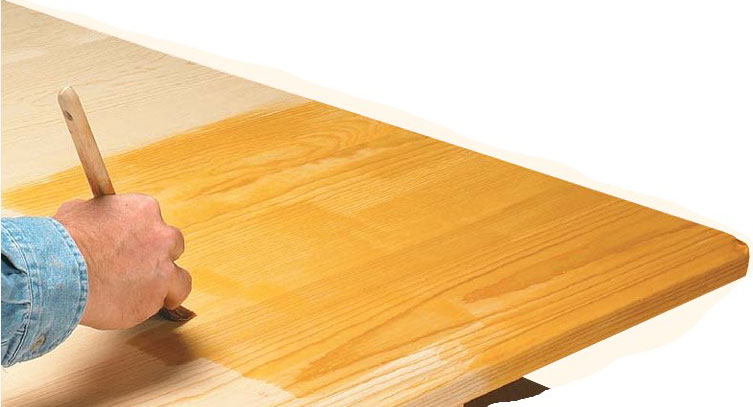
If you just want to give a pine project the warm glow of slightly aged pine, amber shellac is the way to go. As you can see in the photo, a single coat will turn raw pine from it’s natural yellowish-white color to a much more pleasing “pumpkin” pine color. Amber shellac is actually a colored finish, not a stain. So you can avoid the problems (blotching and uneven color) you might have applying a stain. The application is easy and you’ll get a rich, beautiful color on the pine.
APPLYING SHELLAC. I start with a small can of premixed amber shellac. But the off-the-shelf commercial mixes are going to be too thick to flow out well. So the first thing to do is thin the shellac. I usually thin shellac at a rate of of 1 part shellac to 2 parts denatured alcohol. This lightens the color of the amber shellac considerably and will make it much easier to brush out.
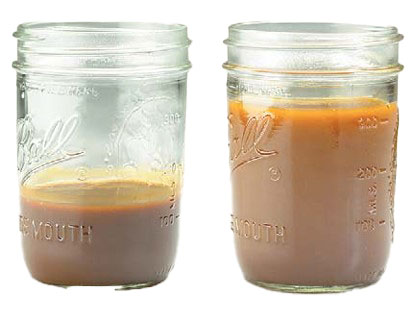
Under the right conditions, shellac dries very fast — within 5 or 10 minutes. Start by applying a thin coat and when it’s dry, sand it lightly. A second coat will give you a little deeper color. Applying multiple light coats gives you greater control over the final color.
TOPCOAT. Now although amber shellac is a finish and forms a film on the wood, I’ll rarely use it without a harder topcoat. It’s just not very water or scratch resistant.
My choice of a topcoat over the shellac is a good quality varnish — either brushed or wiped. Pine is a pretty soft wood, so to me it makes sense to use a pretty hard finish for the best protection. A few coats of polyurethane or a standard varnish will create a tough film and you won’t need to “baby” the soft wood.
A second reason I prefer varnish is the little bit of extra amber color it will impart to the wood. A topcoat of varnish over the shellac will really enhance the warm glow of old pine.
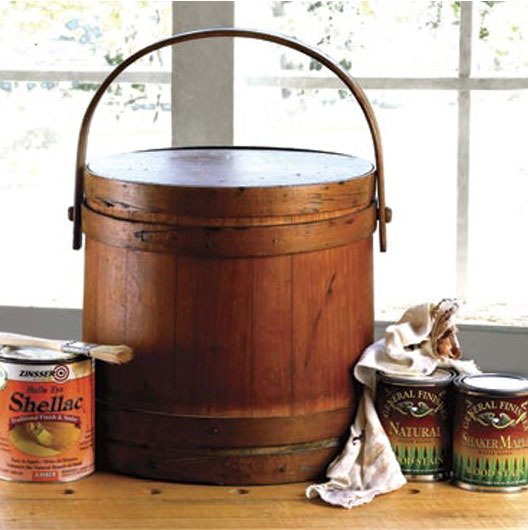
Glen Huey's Pumpkin Pine Finish
One of the biggest roadblocks in using pine is how the finish blotches because of variations in grain density. Finding a reliable way to control the blotching caused by the stain is the task. For that, we used a water-base clear stain.
The pumpkin pine finishing process begins with a coat of natural stain (no pigment present), then a second layer of pigmented stain that adds color, then two coats of shellac as a topcoat. It’s easy to complete the process in one day. the formula begins with a coat of General Finishes wood stain in natural (generalfinishes.com). Don’t be surprised when you open the can. The stain starts as a paste-like goo but dries clear. This product has enough resin in it to partially seal the pine against color penetration, like a wood conditioner. And because it is water-based, it dries faster than oil-based conditioners. The sealing action of this product allows some coloring near the surface of the wood, but it prevents the color from penetrating deeply and blotching.
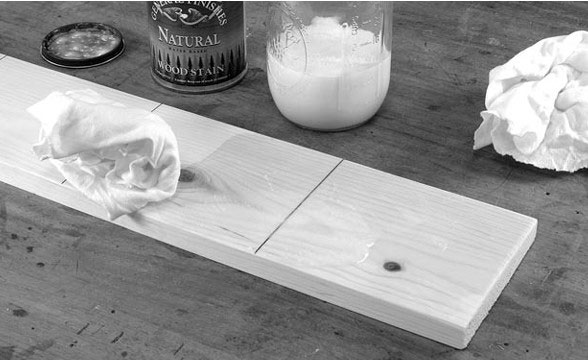
Simply apply a coat onto the surface of the project with a clean cloth then immediately wipe away the excess stain as you rub the goo into the wood. Remove as much as possible when wiping clean, then allow the piece to dry. Drying takes from two to four hours under ideal conditions. If conditions aren’t ideal, small projects can be forced dry with a hair dryer or heat gun.
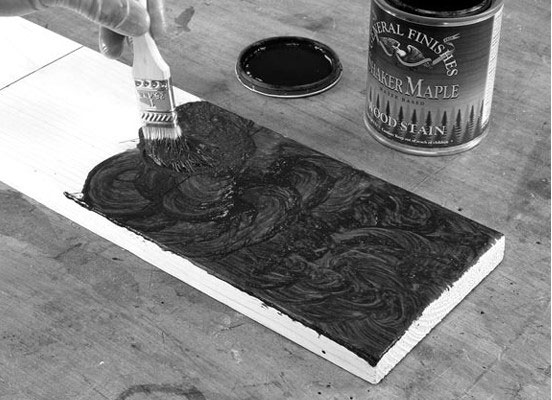
The next layer of stain is also a pasty goo, but with color added. We liked the look of General Finishes "Shaker Maple" water-based stain. Brush on a coat and rub the stain into the wood by twisting the brush bristles. The twisting action pushes the stain into any small scratches to create a uniform color layer. Let the pigmented stain sit on the surface for about five minutes then wipe away any excess. Don’t be tentative. This isn’t like a glaze where you wipe selectively to create faux effects. And we’re not trying to even out any mis-matched coloration. Wipe as much stain off as possible and allow the stain to dry for two to four hours.
The Shaker maple stain adds two important colors. First, it develops the brown shade necessary to present the aged look. Second, it casts a reddish hue onto the piece. Why do we need the reddish hue?
Remember those school days when you studied the primary colors? Yellow and red make orange – or pumpkin, in our case.
The amber shellac delivers the yellow.
Shellac: Is it the Right Stuff? Shellac isn’t the most durable topcoat, and you should always consider how your project will be used before choosing a topcoat. If you’re finishing a tabletop or an area that will experience a lot of wear, a tougher finish is probably called for. Add a more durable topcoat after the pumpkin finish is achieved – but test it first to make sure that it doesn’t affect the pumpkin pine color.
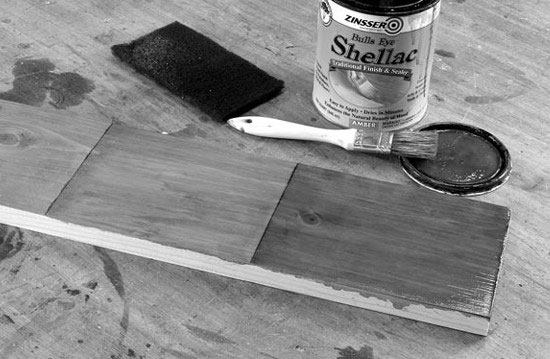
Before applying the first coat of shellac, use a maroon non-woven abrasive pad to knock down any fibers that raised after applying the first coat of water-based stain.
Zinsser’s amber shellac, ready to use right out of the can, is the topcoat. (I said it was easy.) check the date of manufacture while at the store. Outdated shellac – it’s definitely good for a year after the date printed on the can – shouldn’t be used because it won’t dry.
You can brush the shellac onto the piece or apply it with a cotton rag. With either option watch for runs or sags in the finish. A run or sag is actually another layer that increases the color build. Because shellac adds color with each layer, any imperfections such as those will show.
Lightly sand the surface with 400-grit sandpaper once the shellac is dry; don’t sand through the earlier finish.
The next coat of shellac delivered the exact look for our pumpkin pine finish and the surface was thick enough to level to a smooth finish.
You might need a third layer to build the shellac and ensure a smooth finish. If this is so, use a clear shellac because it adds to the thickness without affecting the color. Apply a third coat directly over the previous coats and remember to sand lightly in between.
Once both the color and the thickness of the finish are reached, sand the piece again with 400-grit sandpaper and apply a good coat of paste wax.
Three readily available products with a one-day stretch in the shop, and you’ll have a finish that comes as close to aged pumpkin pine as anything I’ve tried or seen.












